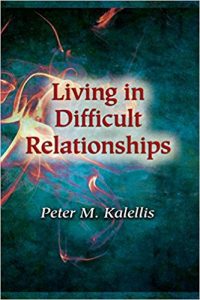Living in Difficult Relationships
by Peter M. Kalellis
 My marriage, like any relationship here on earth, is less than perfect. It has its difficult moments but it is not a difficult relationship. So while Living in Difficult Relationships held professional interest for me, it wasn’t a book I expected to connect with personally. Yet as I read I found myself thinking about relationships with family members, colleagues in parish ministry, and others with whom I deal frequently. Reflection and some reminders about a few relationship principles served me well.
My marriage, like any relationship here on earth, is less than perfect. It has its difficult moments but it is not a difficult relationship. So while Living in Difficult Relationships held professional interest for me, it wasn’t a book I expected to connect with personally. Yet as I read I found myself thinking about relationships with family members, colleagues in parish ministry, and others with whom I deal frequently. Reflection and some reminders about a few relationship principles served me well.
The author of Living in Difficult Relationships, Peter M. Kalellis, is a New Jersey psychotherapist whose practice includes individuals, couples and families. He has written a dozen books, many of them in the self-help genre. In this book Kalellis writes realistically about the challenges of marriage and about ways individuals and couples can help themselves attain a more loving and harmonious marriage.
The main part of the book is divided into three sections on relationship realities, sensitive areas, and sources of strength. Much of the first section pertains to every marriage, not just those that couples consider difficult, and even other types of relationships. There are always individual expectations when two people get to know each other, work together, or stay in communication in more than a superficial way. There are usually assumptions about the way things will go and, when assumptions prove wrong, there is reality to deal with.
Here Kalellis describes three components of marriage: my spouse, the relationship, and myself. “Love, good feelings, joy, and progress can flourish only when all three components of married life have room to grow and no one part dominates or absorbs the other” (p 48). He asserts that marriage requires that spouses take responsibility for everything in their relationship. Harmony is not achieved by false tranquility. A husband and wife can attain harmony only by acknowledging the truth about themselves—the good and the bad—and respecting one another within that honest perspective.
In the book’s second section Kalellis addresses specific challenges, or sensitive areas. There is logic to the order of the first three chapters in this section: disenchantment, frustration, and anger. However, in life there is not necessarily an orderly progression and Kalellis treats each issue more broadly. He also addresses jealousy, relationships with other family members, balancing work with marriage, and managing money. For each he shares good judgment and professional advice in the tone of a wise, caring friend.
Whether a marriage is “a difficult relationship” or simply has difficulties, it needs ongoing sources of strength. The third and most affirmative portion of the book is devoted to showing couples wherein their strength lies. Kalellis begins with what we might expect, love, describing different kinds of love and the contribution of each to marriage. The second strength named is intimacy. In telling the truth about intimacy, the author illustrates his point with a pair of short fables.
Choice and commitment might not at first be thought of as a source of strength, but marriage cannot survive difficulties without it. “Ultimately, every spouse proves to be a disappointment,” Kalellis says, and I won’t dispute him. It didn’t take me many years to realize that I’d married a fantasy. (I assume the same is true for my husband.) I needed more time and the application of some of the book’s advice to rediscover why I’d chosen this man. Then I could renew my commitment to him. Remembering that one has made a choice and consciously, continually committing to that person truly is strengthening.
Finally Kalellis names spirituality as a strength for marriage. He says that psychological answers to life’s basic questions are inadequate, that some invisible power is at work. For those who believe God is part of their marital relationship, he connects lessons from the Bible to marriage. He does so in an even-handed way, with sensitivity for people of all faiths.
Kalellis’ epilogue has a humorous story and an important lesson that should not be missed. His book ends with three appendixes. The first addresses sexuality, the second lists some eminently practical tools for building a successful marriage, and the third is a Marriage Creed with an invitation to write a personal creed.
Readers can count on a steady voice from Kalellis. They can count on every chapter to begin with a thought-provoking quotation and conclude with points to consider. In between they will find the insights of an experienced therapist with a Christian perspective, anecdotes about his own life and couples he has counseled, wisdom from Scripture and other writings, and a few comments and stories that will provoke smiles.
About the reviewer
Mary Ann Paulukonis has been married for more than forty years. In addition to married life she enjoys artistic pursuits, writing, speaking, and ministry consulting.
Disclaimer: Book reviews do not imply and are not to be used as official endorsement by the USCCB of the work or those associated with the work. Book reviews are solely intended as a resource regarding publications that might be of interest to For Your Marriage visitors.




